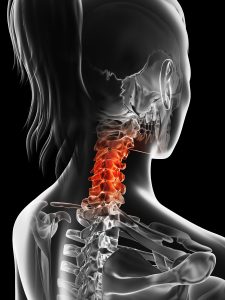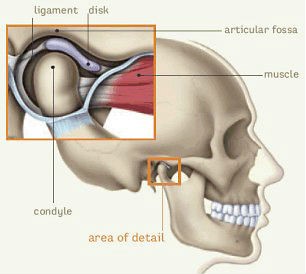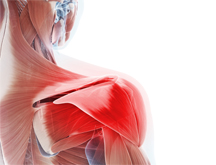
Shoulder Injuries
Shoulder Injuries
Shoulder injuries are a common problem for many people. It can happen to people of all ages from children to the elderly. The pain from shoulder injuries can be very severe and cause a lot of limitations with work and activity. Shoulder pain is one of the top 5 reasons why people seek out Physiotherapy and Registered Massage Therapy treatments.
What Causes Shoulder Pain?
There are several reasons why people suffer from shoulder pain.
-
Trauma
– any type of direct or indirect trauma can produce shoulder pain if the arm and/or shoulder is involved
- Motor vehicle accidents
- Falls
- Sports injuries
- Violent incidents
-
Poor workplace ergonomics
– For people who work in offices, they may spend the majority of their time sitting in front of a computer. If the desk set up is not properly, then this may start to produce stress and pain into the shoulder. For example, poor ergonomics can include:
- poor desk and screen height
- improper positioning of the keyboard and mouse
- inadequate chair height and support
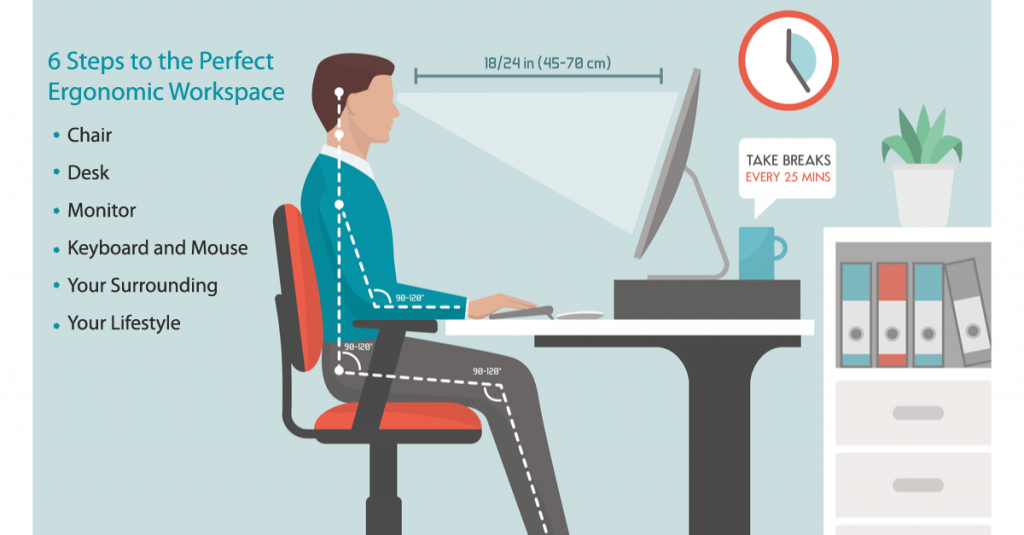
Proper desk ergonomics
-
Poor posture
– Many people have developed poor body postures over time. For some it starts young with spending a lot of time studying. It can also happen after carrying a heavy backpack or playing a lot of video/computer games. For others it starts later in life with workplace demands and poor office set up.
-
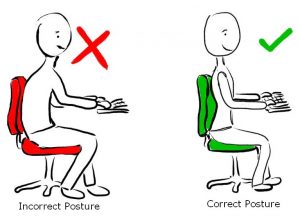
Good-Posture-vs-Poor-Posture
-
Repetitive activities
– Some people perform tasks that are repetitive at work and/or home. If the shoulder is not strong enough to support the work that it’s having to do, then injury may occur. For example,this can include:
- Overhead lifting
- Sorting things on a belt
- Operating heavy machinery
- Typing
-
Congenital or Developmental changes –
- Some people are born with a unique bone structure that may place them at increased risk of injury. For example, the acromion of the shoulder blade can have 4 different shapes. For instance, if you have a hooked shape, there is more potential for rotator cuff injury.
Some Basic Shoulder Anatomy
Having some knowledge of basic shoulder anatomy will help with understanding why shoulder pain develops. The shoulder joint is quite complex. There are a lot of structures that attach to or around the shoulder. The shoulder allows for a lot of movement . As a result, there is less stability through the area. It’s a joint that is held together by soft tissues. Therefore, there is not a lot of bony protection. The shoulder is made of 4 separate joints that work together to allow function:
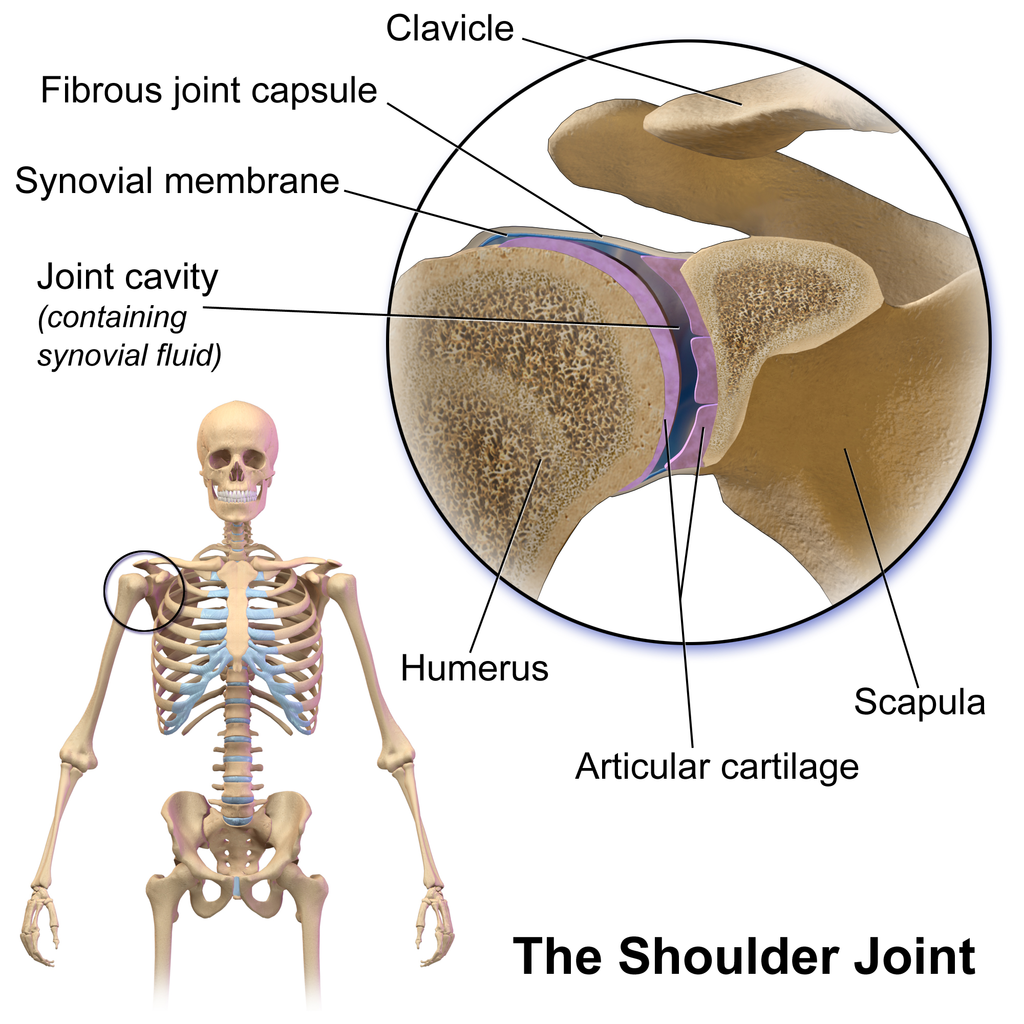
Shoulder Anatomy
- Glenohumeral (GH) joint – this is a ball and socket joint and is where majority of our arm movement happens. The socket is made up by part of the shoulder blade and the ball is made up of the humerus, which is the long bone of the upper arm.
- Acromioclavicular (AC) joint – joint between the acromion of the shoulder blade and the collar bone.
- Sternoclavicular (SC) joint – joint between chest bone and the collar bone.
- Scapulothoracic joint – the joint between the shoulder blade and the ribs at the back of the chest.
The Soft Tissues around the Shoulder Joint
We know that the shoulder is held together by many soft tissues including ligaments, muscles and tendons. Other important structures include the joint capsule surrounding the ball and socket joint. Lastly, your shoulder has subacromial and subdeltoid bursae. The function of the joint capsule is to protect the joint and produce a lubricating fluid. Shoulder bursae are small fluid-filled sacs that act as a cushion between the bone and other moving parts.
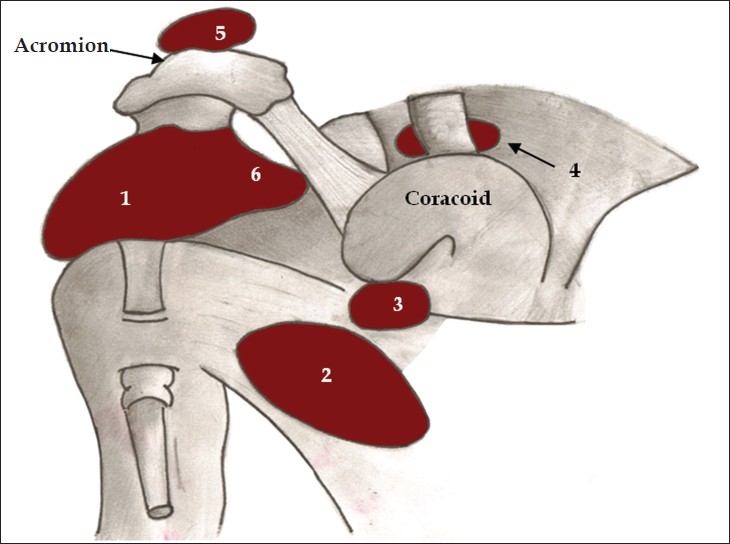
Bursae of the shoulder joint
What are some of the types of injuries that can happen to the shoulder?
- Sprains/Strains of any of the muscles, tendons and ligaments
- Tears/Ruptures of any of the muscles, tendons and ligaments
- Rotator Cuff Tear
- Rotator Cuff Tendonitis
- Tendonitis/Tendinosis
- Fractures
- Bursitis
- Dislocations
- Adhesive Capsulitis or Frozen Shoulder
- Osteoarthritis
- Nerve entrapments/injuries
Signs and Symptoms of Shoulder Injuries
- Pain
- Swelling
- Restricted movement
- Weakness
- Instability
- Bony deformities
Healing Times for Shoulder Injuries
The healing time for shoulder injuries will vary depending on the injury. Most simple sprains/strains will likely take anywhere from 6-8 weeks to get better.
Fractures of the Shoulder can take 6-8 weeks to heal the fracture. After the fracture is healed, the soft tissues may require up to 4-5 months to heal fully with proper Physiotherapy.
However, frozen shoulders can take over 1 year to improve. There are also a lot of individual differences in healing time amongst different people, even for similar injuries. For example, some of these factors can include:
- Age
- Severity of Injury
- Was surgery required ?
- Level of fitness and/or mobility
- Commitment to treatment
- Ability to modify workplace or home environment to allow for best treatment response
- Presence of other injuries
- Amount of time that the injury/pain has been present
Physiotherapy/Massage Treatment for Shoulder Injuries
Treatment for shoulder pain will depend on the type of injury. It will also depend on the area that has been injured.
However, since the shoulder is made up of 4 joints, treatments should target the whole shoulder and not just the individual area injured. This will allow the shoulder to return to its full function. It will also reduce the risk of re-injury.
In sum, the main goals of any shoulder pain treatment will be to:
- Decrease pain
- Regain full movement
- Recover strength and stability
- Return to pre-injury activities
Registered Physiotherapy for Shoulder Injuries
A Registered Physiotherapist will start with a full assessment so that we can identify the source of the shoulder pain. This will allow us to provide the best treatment for you. Treatment can typically include:
- Manual therapy
- soft tissue work
- mobilizations
- assisted stretching of the shoulder and nearby areas
- Modalities – these are usually used in the early phase for pain relief
- Ultrasound
- Laser
- IFC or TENS
- Heat/Ice
- Exercise prescription
- Movement and strengthening exercises that are specific to the injury
- So, it is important that you complete the prescribed exercises on a regular basis at home.
- In short, this will ensure that you are continually providing treatment to the shoulder even when you are not physically present in the clinic.

- Education
- Explanation of the condition
- Rationale for the treatment choices
- In essence, Do’s and don’ts to help the injury along
Registered Massage Therapy for Shoulder Injuries
- Registered Massage Therapy can be very helpful to release tight muscles around the upper back, neck and shoulder blades
-

Registered Massage therapy for shoulder injuries
Shoulder injuries can be quite debilitating, and it is important to seek out a Registered Physiotherapist for assessment and treatment sooner rather than later. Like most other injuries, the longer an injury is left untreated, the more chronic it becomes. As a result, it makes it more difficult to resolve in a timely manner.
Call PhysioNow today to get treatment for your shoulder injury!


